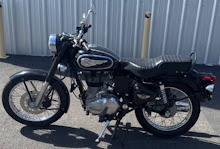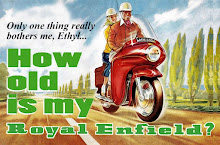 |
| Royal Enfield's Redditch, Britain factory circa 1950s. |
Author Anne Bradford collected the memories of more than 80 Royal Enfield factory workers for her 1996 book "Royal Enfield, The Story of the Company and the People Who Made It Great: 1851-1969."
Not all of those memories fit into the book. Fortunately, the author left an archive of the entire contributions she gathered, including the parts omitted from the book, so historians can get a broader view of life at Royal Enfield factories in Redditch, Britain.
In the book, Bradford described Redditch before Royal Enfield as having had "a sprinkling of dark, satanic mills."
Royal Enfield workers would operate in brighter, safer surrounds, eventually in a brand new factory, but industrial danger was unavoidable.
Gilbert Hunt worked at Royal Enfield from 1922-1933. His contribution was considerably shortened for the book, but he was a colorful storyteller who didn't balk at the macabre.
He is only one of several contributors who mention the danger of getting caught up in the long leather belts that carried motion to the machine tools. There was disease, too. Tuberculosis was at least suspected.
And then there was the danger posed by the product itself. Hunt recalls that Royal Enfield executive Major Smith was driving an experimental machine that had a steering wheel in the sidecar and no handlebars on the motorcycle. He lost control at the bottom of Bates Hill and rolled three times, suffering a broken nose.
But Hunt ends with admiration: "The last time I saw him he must have been in his seventies and he was riding a 692cc Constellation, still going to work."
"Dolly" worked at the factory from 1928-1953. Trimmed from the book was a story she told about hearing that there is a picture of her in one of the magazines. If you spot it, she says, look for the string holding her shoes on; oil on the factory floor spoiled shoes, so the girls wore their oldest pair.
Left out of the book, too, is her comment that "I worked there for 25 years in all and I enjoyed very minute of it."
Author Branford notes from the start of the book that many of her contributors cautioned that their recollections of so long ago may be inexact.
Her concern for accuracy is apparent. For instance, Bradford writes that Harry Hughes, who worked for Royal Enfield from 1921-1969, passed away before there was a chance to check over with him the contents of his 1994 contribution.
But there's no doubt he did accurately remember being laid off just six months before his 50th year of service -- missing out on the customary gold watch.
John Latter (1926-1939) didn't rave about working at Royal Enfield. He complained of how hard it was to be paid on the piece work system. He found the rates set so unjust in one department that he and a co-worker pooled their earnings to even things out.
Another problem was cuts in hours. Fed up with not working full time at Royal Enfield, Latter sought a job at the Austin factory -- only to discover that Austin and Enfield had an agreement not to hire away each other's workers.
A sympathetic executive at Royal Enfield gave him a note to let Austin know it was OK to hire him.
Bert Wedgebury (1928-1967) considered the bicycle assembly department -- the "Chain Wheel Gang" -- the mainstay of the factory. The motorcycle business had ups and downs, but there was always demand for bicycles. Not that it paid particularly well, but he liked his co-workers.
In particular there were the women who worked in the adjacent department, lacing bicycle wheels. They used to "get a whistle" when they walked past. He asked an especially nice one, named Beatrice, for a date. She didn't show up the first time, so he asked again. They later married.
Wartime service interrupted Wedgebury's employment, but in 1941 Royal Enfield pulled him back for months of "essential service" -- testing motorcycles made for the army.
The push was on to get them out the door, so the hours were long and conditions hard. Testing each bike meant nine miles on the road, even in the dark, with only the shuttered blackout headlight for illumination.
Eddie Wright (1925 to closure) remembered how the war finally changed some pay scales at Royal Enfield. Competing factories had government contracts and could pay more, so Royal Enfield had to compete for workers. Even within the Redditch factory, and between Redditch and other Royal Enfield factories, workers doing government work were paid substantially more for the same tasks.
Wright's tasks, at the end, sadly included closing and decommissioning the works.
Jack Normandale (1940-1961) gave Anne Bradford an extensive description of the underground factory at Westwood, near Bath. Employed at Redditch, he and his wife volunteered for the cave factory in 1942, during World War II.
Left out of the book is his description of the benefits of moving to Westwood: Royal Enfield paid for the move, and provided a three-bedroom bungalow. Black-out curtains had been fitted, and mats provided, along with color wash for the interior walls, and a supply of coal in the bunker. The bungalow across the street had a better garden, so he angled to get it instead.
Also not in the book is that the couple worked 60 hours a week, 8 a.m. to 6 p.m. six days a week, with a Saturday afternoon off once a month. For him there was one evening a week on Home Guard practice (running across a field with a bayonet) and then a Home Guard parade on Sunday morning.
I hope he found time to enjoy his garden!
Contributor Vic Bott described the post-war enthusiasm. But at Royal Enfield there was aggravation with materials shortages.
He was instrumental in creating a production line; no longer would one man assemble an entire bike. This made him unpopular with the workers, at least at first.
Bott also created Royal Enfield's displays for the Earls Court motorcycle shows, sometimes involving moving parts that made the motorcycles on the stand seem to run.
The big stands at the show were Triumph, AJS, BSA, Norton, and Royal Enfield and, of course there, was competition between them.
Bott fondly remembered the year Royal Enfield was a sensation, with the introduction of the swinging arm rear suspension. "We knew it was good but we didn't realize that it was going to be the success that it was."
Bott had a cut-away demonstration bike riding on rollers to simulate a rough road, with the swinging arm taking it in stride. Show goers wondered "how do they do it?"
Left out of the book, too, was Bott's description of how little Prince Charles almost didn't get the specially painted and equipped child's bicycle the factory planned to present to his father, the Duke of Edinburgh, at the show. Just before the show Bott caught a man making off with the bicycle, and called security.
Edna Kinchin joined Royal Enfield in 1935, at the age of 14, starting "like all the new office girls" in the Post Room. This involved picking up the mail and taking mail around the factory and to other factories in town. "I suppose I was cheaper than the postage."
Her description of wartime fashions is interesting ("we put gravy browning on our legs" -- there were no nylons) but this didn't make the book.
As it would be expected, contributions from executives or influential designers were less likely to be omitted from the book than the recollections of others. But one omission was designer Reg Thomas's memory of an incident at the Earls Court Show:
"I can vouch for Roger's tale of the dealer from Scotland falling into the floral display, I was at the show that evening and remember it well!"
Told by Roger Boss (1950-1967) it is a wonderful story, omitted from the book, about the Royal Enfield dealer who became inebriated at the Earls Court Show, finally ending up in the floral arrangements at another booth.
Discovering he had a train ticket to Edinburgh in his wallet, the Royal Enfield executives present loaded him into a taxi, took him to his hotel, packed for him, got him to the train, and bribed a guard to keep an eye on him.
"A few days later Enfield received a letter of thanks from him."
One other omission I think I can explain from my own research. Reg Thomas said "I do remember having one showdown with Vic (Mountford) after he became managing director."
I've blogged about that incident here.
We'll dig more into more omissions from Anne Bradford's book in my next blog item.





























No comments:
Post a Comment